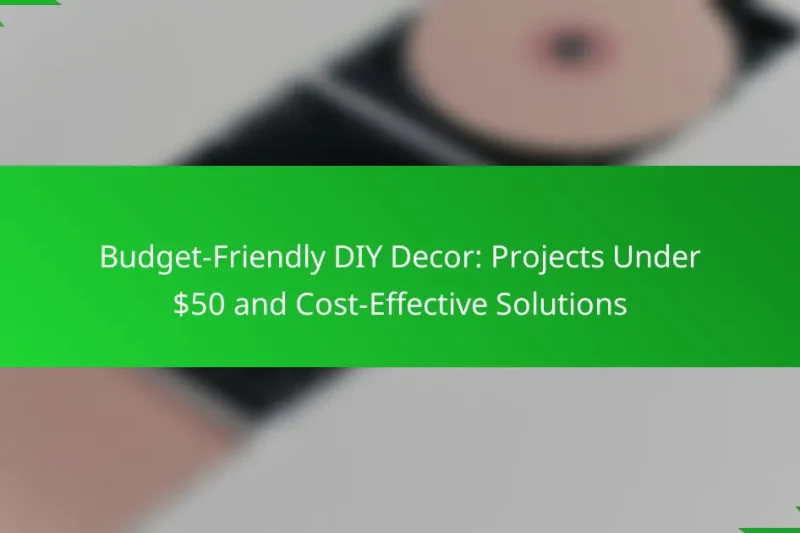Transforming your living space doesn’t have to be expensive, and budget-friendly DIY decor projects under $50 … Budget-Friendly DIY Decor: Projects Under $50 and Cost-Effective SolutionsRead more
DIY Home Decor Ideas
Transforming your living space with DIY home decor can be both fun and rewarding. By focusing on functionality and aesthetics, you can create inviting environments that reflect your personal style without breaking the bank. Explore creative solutions like multi-functional furniture and upcycled materials to enhance your home while embracing the latest trends in sustainable design.
DIY Home Decor Projects: Beginner-Friendly, Upcycling, Wall Ideas, Seasonal Refresh
Transform your living space with beginner-friendly DIY home decor projects that are both simple and budget-friendly. … DIY Home Decor Projects: Beginner-Friendly, Upcycling, Wall Ideas, Seasonal RefreshRead more
Upcycling Furniture: Stylish Decor and Creative Transformations
Upcycling furniture is a creative way to breathe new life into old or unused pieces, transforming … Upcycling Furniture: Stylish Decor and Creative TransformationsRead more
DIY Decor for Small Apartments: Space-Saving Ideas and Functional Designs
Transforming a small apartment into a stylish and functional space is entirely possible with the right … DIY Decor for Small Apartments: Space-Saving Ideas and Functional DesignsRead more
DIY Wall Decor: Personalized Touch and Unique Ideas
Transform your living space with DIY wall decor that showcases your creativity and personal style. From … DIY Wall Decor: Personalized Touch and Unique IdeasRead more
What are the best DIY home decor ideas for small spaces?
For small spaces, the best DIY home decor ideas focus on maximizing functionality while enhancing aesthetics. Consider solutions that save space and create an inviting atmosphere, such as multi-functional furniture and clever storage options.
Multi-functional furniture
Multi-functional furniture is essential in small spaces, as it serves more than one purpose. For example, a sofa bed can provide seating during the day and transform into a sleeping area at night. Look for ottomans with storage or coffee tables that can double as workspaces to optimize your area.
When selecting multi-functional pieces, ensure they fit your style and space without overwhelming it. Measure your area carefully to avoid clutter and maintain a comfortable flow.
Wall-mounted shelves
Wall-mounted shelves are a practical solution for small spaces, as they utilize vertical space without taking up floor area. They can display books, plants, or decorative items, adding personality without sacrificing room. Consider floating shelves for a sleek look or corner shelves to make use of otherwise wasted space.
Be mindful of weight limits when installing shelves, especially if you plan to store heavier items. Use appropriate anchors and brackets to ensure stability and safety.
Vertical gardens
Vertical gardens are an innovative way to bring greenery into small spaces without occupying ground space. You can create a vertical garden using wall planters or hanging pots, which can improve air quality and add a vibrant touch to your decor. Herbs or small plants work well in these setups.
Choose plants that thrive in your specific light conditions, and consider using a drip irrigation system for easy maintenance. Regularly check for pests and ensure proper drainage to keep your vertical garden healthy.
Mirrors for depth
Using mirrors strategically can create the illusion of depth and space in small areas. A large mirror on one wall can reflect light and make a room feel larger and brighter. Consider mirrored furniture or decor accents to enhance this effect.
Position mirrors across from windows or light sources to maximize their impact. Be cautious with placement to avoid creating awkward reflections or distractions.
Light color palettes
Light color palettes can significantly influence the perception of space in small rooms. Soft whites, pastels, and light grays can make a room feel airy and open. Incorporate these colors in your walls, furniture, and decor to create a cohesive look.
When choosing colors, consider the natural light available in your space. Lighter colors reflect light better, while darker shades can make a room feel smaller. Use colorful accents sparingly to maintain a balanced aesthetic.
How can I create a budget-friendly home decor?
Creating budget-friendly home decor involves using affordable materials and repurposing items you already own. Focus on creativity and resourcefulness to transform your space without overspending.
Repurposing old furniture
Repurposing old furniture is an effective way to save money while adding character to your home. Consider giving a fresh coat of paint to a worn-out dresser or turning an unused ladder into a stylish bookshelf.
Before starting, assess the condition of your furniture. Look for pieces that can be easily updated with minimal effort, such as changing hardware or reupholstering seats. This approach not only saves money but also reduces waste.
Using thrift store finds
Thrift stores are treasure troves for unique home decor items at low prices. You can often find vintage furniture, decorative pieces, and art that can be easily integrated into your home.
When shopping, keep an open mind and look for items that can be easily restored or customized. For example, a simple coat of paint can breathe new life into an outdated lamp. Set a budget for your thrift store visits to avoid overspending.
DIY wall art
Creating your own wall art is a cost-effective way to personalize your space. Simple projects like canvas paintings, framed fabric, or photo collages can make a significant impact without breaking the bank.
Gather materials from local craft stores or use items you already have at home. Consider using natural elements like pressed flowers or leaves for a unique touch. Aim for a cohesive color scheme to ensure your art complements your existing decor.
Homemade decorative pillows
Homemade decorative pillows can enhance your living space while being budget-friendly. Sewing your own pillows allows you to choose fabrics that match your style and decor.
Start with basic sewing skills and select fabric that fits your theme. You can repurpose old clothing or buy fabric remnants to keep costs low. Use pillow inserts or stuffing from old pillows to fill your creations, ensuring comfort and style without overspending.
What are popular DIY home decor trends in 2023?
In 2023, popular DIY home decor trends focus on creating sustainable, functional, and aesthetically pleasing spaces. Key trends include biophilic design, minimalist aesthetics, upcycled materials, and smart home integration, all of which enhance the home environment while reflecting personal style.
Biophilic design
Biophilic design emphasizes the connection between nature and indoor spaces. Incorporating natural elements like plants, water features, and natural light can improve well-being and create a calming atmosphere.
To implement biophilic design, consider adding indoor plants, using natural materials like wood and stone, and maximizing natural light through larger windows or light-colored curtains. Aim for a balance between indoor and outdoor spaces to enhance the overall aesthetic.
Minimalist aesthetics
Minimalist aesthetics prioritize simplicity and functionality, often featuring clean lines and a neutral color palette. This trend encourages decluttering and choosing quality over quantity in decor items.
To achieve a minimalist look, focus on essential furnishings and decor that serve a purpose. Use a limited color scheme, and incorporate multifunctional furniture to maximize space without sacrificing style.
Upcycled materials
Upcycled materials involve repurposing old items into new decor, promoting sustainability and creativity. This trend not only reduces waste but also adds unique character to your home.
Consider transforming old furniture with a fresh coat of paint or turning glass jars into decorative storage. Look for local workshops or online tutorials that can guide you in upcycling projects, making it both a fun and environmentally friendly endeavor.
Smart home integration
Smart home integration involves using technology to enhance convenience and efficiency in home decor. This trend includes smart lighting, thermostats, and security systems that can be controlled remotely.
To incorporate smart home features, start with devices that suit your lifestyle, such as smart bulbs that change color or smart speakers that control music and lighting. Ensure compatibility with existing systems and consider the ease of use to create a seamless experience in your home.
What materials are best for DIY home decor projects?
Choosing the right materials for DIY home decor projects is essential for achieving the desired look and durability. Common materials include wood, fabric, and paint, each offering unique benefits and applications.
Wood for rustic decor
Wood is a popular choice for creating rustic decor due to its natural beauty and versatility. Options like reclaimed wood can add character and charm, while new wood can be easily customized with stains or finishes.
When selecting wood, consider the type and grain pattern. Softwoods like pine are budget-friendly and easy to work with, while hardwoods like oak provide durability and a more polished appearance. Always check for any imperfections or warping before purchasing.
Fabric for soft furnishings
Fabric is essential for soft furnishings such as cushions, curtains, and upholstery. Choosing the right fabric can enhance comfort and style; options range from cotton and linen to more luxurious materials like velvet.
When selecting fabric, consider durability and ease of cleaning, especially for high-traffic areas. For example, upholstery fabric should be stain-resistant and durable, while lighter fabrics may be suitable for decorative cushions. Always pre-wash fabrics to prevent shrinkage.
Paint for upcycling
Paint is a transformative material for upcycling furniture and decor items. It allows you to refresh old pieces and customize colors to fit your decor scheme. Chalk paint, for instance, is popular for its matte finish and ease of use.
Before painting, prepare surfaces by cleaning and sanding as needed. Use primer for better adhesion, especially on glossy surfaces. Consider using eco-friendly paints that have low volatile organic compounds (VOCs) for a healthier home environment.




